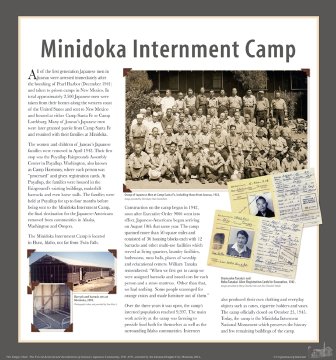|
Description
|
| Minidoka Internment Camp All of the first generation Japanese men in Juneau were arrested immediately after the bombing of Pearl Harbor (December 1941) and taken to prison camps in New Mexico. In total approximately 2,500 Japanese men were taken from their homes along the western coast of the United States and sent to New Mexico and housed at either Camp Santa Fe or Camp Lordsburg. Many of Juneau's Japanese men were later granted parole from Camp Santa Fe and reunited with their families at Minidoka. The women and children of Juneau's Japanese families were removed in April 1942. Their first stop was the Puyallup Fairgrounds Assembly Center in Puyallup, Washington, also known as Camp Harmony, where each person was "processed" and given registration cards. At Puyallup, the families were housed in the Fairground's existing buildings, makeshift barracks and even horse stalls. The families were held at Puyallup for up to four months before being sent to the Minidoka Internment Camp, the final destination for the Japanese-Americans removed from communities in Alaska, Washington and Oregon. The Minidoka Internment Camp is located in Hunt, Idaho, not far from Twin Falls. Construction on the camp began in 1942, soon after Executive Order 9066 went into effect. Japanese-Americans began arriving on August 10th that same year. The camp spanned more than 50 square miles and consisted of 36 housing blocks each with 12 barracks and other multi-use facilities which served as living quarters, laundry facilities, bathrooms, mess halls, places of worship and educational centers. William Tanaka remembered: "When we first got to camp we were assigned barracks and issued cots for each person and a straw mattress. Other than that, we had nothing. Some people scavenged for orange crates and made furniture out of them." Over the three years it was open, the camp's interned population reached 9,397. The main work activity at the camp was farming to provide food both for themselves as well as the surrounding Idaho communities. Internees also produced their own clothing and everyday objects such as canes, cigarette holders and vases. The camp officially closed on October 23, 1945. Today, the camp is the Minidoka Interment National Monument which preserves the history and few remaining buildings of the camp. Image captions: Group of Japanese Men at Camp Santa Fe, including those from Juneau, 1942, image provided by the Empty Chair Committee. Barrack at Minidoka, 2003, photograph taken by and courtesy of Sam Kito. Barrack Cots at Minidoka, 2003, photograph taken by and courtesy of Sam Kito. Shonosuke and Nobu Tanaka's Alien Registration Cards for Evacuation, 1942. Image courtesy of the Tanaka family. |
Minidoka Internment Camp History Panel
-The Empty Chair: The Forced Removal and Relocation of Juneau's Japanese, 1941-1951
-Permission to use this image may be obtained by contacting museum staff.

All images are the property of the Juneau-Douglas City Museum. No image may be copied, downloaded or reproduced without the express permission of the Juneau-Douglas City Museum.

All images are the property of the Juneau-Douglas City Museum. No image may be copied, downloaded or reproduced without the express permission of the Juneau-Douglas City Museum.